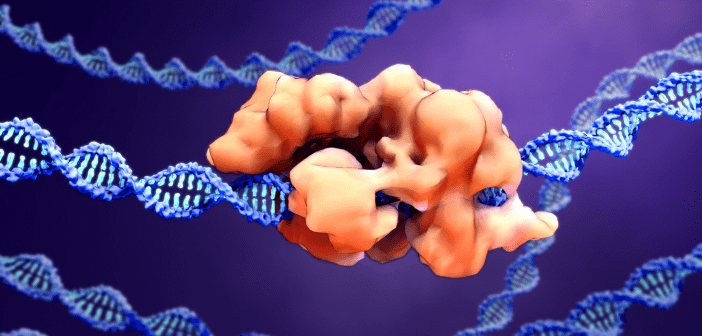CRISPR-Cas9: New technique paves the way for safer gene editing by reducing the number of unwanted mutations

A new and improved genome-editing method using CRISPR-Cas9 technology, that greatly reduces mutations has been established, enabling the development of more efficient therapies with reduced incidence of undesired genetic mutations.
CRISPR-Cas9 technology is commonly used for genome editing and correction, by precisely cleaving regions of DNA and then adding, removing or altering sections of the DNA section. The technique allows for the studying of genes of interest and the alteration of disease-associated genes.
However, CRISPR-Cas9 technology does come equipped with its own risks, as the process is associated with side effects such as toxicity and undesired mutations. This is frequently caused by the enzyme’s preference for genomic sites that share a similar sequence with the intended target site. Likewise, modifying genes can lead to chromosomal mutations, impeding clinical trials for cancer gene therapies.
Researchers at Kyushu University (Fukuoka, Japan) and Nagoya University School of Medicine (Nagoya, Japan) theorized that the existing editing protocols that use the enzyme Cas9 cause excessive DNA cleavage, which in turn leads to the undesired mutations. Their findings were published in the journal, Nature Biomedical Engineering.
To test their hypothesis, the group consisting of Assistant Professor Masaki Kawamata at Kyushu University (Fukuoka, Japan) and Professor Hiroshi Suzuki at the Nagoya University Graduate School of Medicine (Nagoya, Japan), created a system called allele-specific indel monitor system (AIMS) in mouse cells, which assessed Cas9 activity individually for each chromosome. Their work revealed that the commonly used method of CRISPR-Cas9 was associated with excessively high editing activity, and they established that this heightened activity was responsible for some of the undesirable side effects. To rectify this issue, the team sought out a guide RNA (gRNA) modification method that could suppress the high editing activity. They discovered that the use of an extra cytosine extension to the 5′ end of the gRNA was a successful defense to act as a safeguard for excessive editing and allowed for regulation over DNA cleavage.
You may also be interested in:
- Tracking the therapy: the roles of bioanalysis in AAV-dosed gene therapy trials
- Life finds a way: 2.6 billion year old ancestors of CRISPR system discovered
- Bioanalytical considerations for gene and cell therapeutic products
Employing their novel approach, the research team succeeded in reducing the number of off-target effects and levels of cytotoxicity. This in turn boosted the efficacy of single-allele selective editing and enhanced the efficiency of homology-directed repair, which is the leading mechanism employed for repairing DNA double-strand breaks.
In order to examine the effectiveness of the technique in a clinical setting, the team chose to investigate a rare disease known as fibrodysplasia ossificans progressiva. Through the use of a mouse model, the research team was able to generate a genotype identical to the human version of the disease. Afterward, the team employed patient-derived iPS cells to accurately repair any damage seen at the single nucleotide level, in the particular disease-linked allele that triggers the disorder. This thereby illustrates the efficacy and safety of their technique as a gene therapy approach.
The research team also created the first mathematical model displaying the association between various genome-editing patterns and the activity Cas9. This model allows for the simulation of the results of genome editing within a whole cell population.
Professor Suzuki stated,
“We established a new genome editing platform that can maximize the desired editing efficiency by developing activity-regulating [C]gRNAs with appropriate Cas9 activity. Furthermore, we found that ‘safeguard gRNA’ can be applied to various CRISPR tools that require gRNAs by regulating their activities, such as those using Cas12a, which has a different DNA cleavage mechanism,” said Professor Suzuki. “For techniques that use Cas9 to activate or repress genes of interest, such as CRISPR activation and CRISPR interference, excessive induction or suppression of gene expression may be not useful and even harmful to cells. Controlling expression levels by [C]gRNA is an important technology that can be used for various applications, including the implementation of precise gene therapy.”
The research team is looking to expand on their findings and create a start-up business. Dr Kawamata commented,
“In particular, we believe that this technology can make a significant contribution to the medical field,” said Dr Kawamata. “We are currently evaluating its therapeutic efficacy and safety for selected target diseases in cell and animal experiments and using it to help develop therapeutic drugs and gene therapy methods, especially for rare diseases for which no treatment methods have yet been established.”
Source: Kawamata M, Suzuki I, Kimura R, et al. Optimization of Cas9 activity through the addition of cytosine extensions to single-guide RNAs. Nat. Biomed. Eng (2023). doi: 10.1038/s41551-023-01011-7, https://www.eurekalert.org/news-releases/985279






